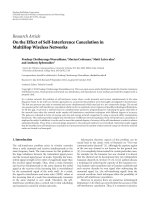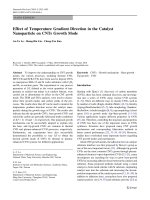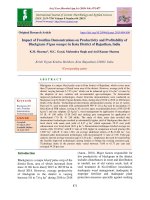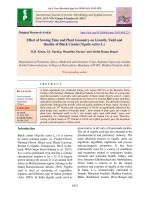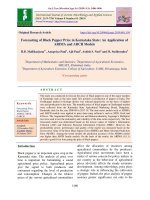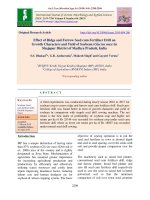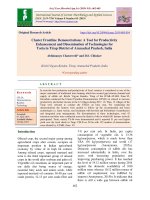Effect of nitrogen and phosphorous fertilizer application on growth and yield of black cumin cultivation in Malda district (WB)
Bạn đang xem bản rút gọn của tài liệu. Xem và tải ngay bản đầy đủ của tài liệu tại đây (156.22 KB, 5 trang )
Int.J.Curr.Microbiol.App.Sci (2019) 8(4): 2813-2817
International Journal of Current Microbiology and Applied Sciences
ISSN: 2319-7706 Volume 8 Number 04 (2019)
Journal homepage:
Original Research Article
/>
Effect of Nitrogen and Phosphorous Fertilizer Application on Growth and
Yield of Black Cumin Cultivation in Malda District (WB)
Samima Sultana1*, Adwaita Mondal1, Srabani Das2, B.C. Rudra1,
Banaz Alam3 and Saurav Roy4
1
Malda KVK, UBKV, India
Seva Bharati KVK, Kapgari, Jhargram, India
3
Jalpaiguri Krishi Vigyan Kendra, WBUFAS, India
4
Department of PSMA, BCKV, India
2
*Corresponding author
ABSTRACT
Keywords
Nigella, Black
cumin, Inorganic
fertilizer
Article Info
Accepted:
20 March 2019
Available Online:
10 April 2019
Nigella (Nigella sativa L.) is a spice crop that belongs to Ranunculaceae family. The seeds
or grains resembling onion seed, are used both as spice and medicine. In Malda district of
WB, this crop do not cultivated earlier time but recent 2 to 3 Years it is introduced as a
new seed spices which opens new avenues for the farmers by not only the choice of crops
but also improve their revenue from the land. The present investigation was carried out
during rabi 2017 and 2018 in the Malda district on, optimum N and P application levels to
get high yield and quality in nigella four levels of nitrogen (0, 20, 40 and 60 kg nitrogen
(N) ha-1) and phosphorus (0, 15, 30 and 45 kg phosphorus (P)/ha. The study on application
of different levels of nitrogen and phosphorus revealed that all the traits were influenced
by N and P application. There was interaction effect in the traits like plant height (60, 90
DAS and at harvest), capsule yield, husk yield. N and P application levels improved the
plant height, number of leaves per plant and number of branches per plant at different
stages of growth. Similar response was observed in fresh and dry matter accumulation.
Minimum total chlorophyll content, The yield contributing characters like capsule weight
at harvest, capsule length and diameter, number of capsules, number of seeds per capsule,
test weight, capsule yield per plant and grain yield per plant increased with level of
application of N and generally maximum values were observed in highest N application.
Similar response was observed with P application. Seed yield and stalk yield were
maximum at highest N application. Seed yield was maximum with the application of
phosphorus 45 and 30 kg /ha. The uptake of N, P and K increased with the increase of N
and P applications. Lower available nitrogen and potassium, and higher available
phosphorus status was observed after harvest than initial soil status. The highest Benefit
Cost Ratio (BCR) was recorded with the crop sown during the October. The application of
60 /kg N ha in two splits as basal and at 35 DAS with 30.
2813
Int.J.Curr.Microbiol.App.Sci (2019) 8(4): 2813-2817
Introduction
Nigella (Nigella sativa L.) is a spice crop that
belongs to Ranunculaceae, the butter cup
family. The seeds or grains resembling onion
seed, are used both as spice and medicine. It
is believed to have originated in the
Mediterranean region and subsequently
spread to Europe, Asia and Africa. Seeds of
this plant were used both as spice and
medicine since a very long time. The seeds
are bitter in taste and consumption of whole
seed even in small quantity gives a feeling of
constriction of throat. It is appropriately
known as seed of blessing (habbatul barakah)
(Srivastava, 2014). The spice was attributed
with numerous medicinal properties and is
widely used in unani, ayurveda, siddha and
other ethnomedicine systems across the world
(Padmaa, 2010). The medicinal value of the
spice is immense and numerous workers
appreciated its unique, varied and powerful
pharmacological traits. The popularity of the
plant was highly enhanced by the ideological
belief in the herb as a cure for multiple
diseases. likes anti-tumour anti-diabetic,
cardioprotective,
gastroprotective),
antiasthmatic,
nephroprotective,
hepatoprotective,
antiinflmmatory,
immunomodulatory,
neuroprotective,
anticonvulsant,
anxiolytic,
antioxidant,
antinociceptive, antioxytocic, contraceptive,
antibacterial antifungal, and anthelmintic
activities were immensely appreciated. The
major
medicinal
components
are thymoquinone and nigellone (a dimer of
thymoquinone). These were attributed to
impart anti-tumour, anti-inflammatory and
anti-diabetic properties (Woo et al., 2012).
The crop is presently cultivated in parts of
Asia, Africa, Europe and Americas of the
globe. The major producing countries are
India, Sri Lanka, Bangladesh, Afghanistan,
Pakistan, Egypt, Iran, Iraq, Syria, Turkey and
Ethiopia. In India, it is grown in many parts,
particularly in Madhya Pradesh, Bihar,
Punjab, Assam, Jammu and Kashmir,
Himachal Pradesh, Uttar Pradesh, Rajasthan,
West Bengal and Tamil Nadu. Among the
countries that export black cumin, the major
ones are India, Syria, Ethiopia and Turkey.
The major seed spices grown in West Bengal
are coriander, fenugreek, cumin, black cumin
and Fennel. Nigella though found suitable as
rabi crop for West Bengal. In Malda district
of WB, this crop do not cultivated earlier time
but recent 2 to 3 Years it is introduced as a
new seed spices which opens new avenues for
the farmers by not only the choice of crops
but also improve their revenue from the land.
The present investigation was carried out
during rabi 2017 and 2018 in the Malda
district on, optimum N and P application
levels to get high yield and quality in nigella
four levels of nitrogen (0, 20, 40 and 60 kg
nitrogen (N) ha-1) and phosphorus (0, 15, 30
and 45 kg phosphorus (P)/ ha. The study on
application of different levels of nitrogen and
phosphorus revealed that all the traits were
influenced by N and P application.
Materials and Methods
The experiment was conducted in farmer’s
field of Malda district, West Bengal, India,
during the year 2017-18 with high yielding
black cumin variety.
Geographically,
experimental site situated at 23.5° North
latitude, 89° East longitude having an average
altitude of 9.75 m above mean sea level. The
experimental site was located in sub-tropical
humid climate with gangetic old alluvial soil,
sandy clay loam texture, good water holding
capacity, well drained, and with acidic to
neutral reaction and moderate fertility status.
The experiment Design was randomized
block design (RBD) with four (8) treatments.
The treatments are four levels of nitrogen (0,
20, 40 and 60 kg nitrogen (N) ha-1) and
phosphorus (0, 15, 30 and 45 kg phosphorus
(P)/ ha. The experiment land was plowed,
2814
Int.J.Curr.Microbiol.App.Sci (2019) 8(4): 2813-2817
cultivated and then prepared for seed sowing
through broadcasting method. For the
experiment on different dates of sowing well
rotten farm yard manure was applied as a
basal dose at the rate of 20 quintal per
hectare. The crop was fertilized with nitrogen,
phosphorus form of urea, single super
phosphate respectively. The application of 60
/kg N ha in two splits as basal and at 35 DAS
with 30 and full dose of ssp was applied as
basal. Seeds were sown by hand in mid week
of October in the ratio of 15 kg /ha. The
distance between rows was 20 cm and within
the rows were 5 cm. Seeds were sowed at 1-2
cm depths soil.
rows from each plot were harvested first
leaving the net plot area. Later, net plot area
was harvested after separating the plants
designated
for
recording
biometrical
observations. The harvested plants were
sundried for three days and threshing was
done by beating with sticks. The seed was
winnowed and cleaned subsequently for
recording yield data
Observations on the crop
Plant height, no of branches per plant,
yield/ha was recorded.
Results and Discussion
The crop was irrigated immediately after
sowing for obtaining better and uniform
germination. Subsequent irrigation were given
as when require to maintain uniform soil
moisture throughout the crop growth period.
Immediately after the germination of the
seeds, gap filling was taken up to maintain
uniform plant population. First thinning was
taken up to maintain optimum plant
population at 15 DAS and second thinning
was taken up 10 days after the first thinning.
The experimental plot was kept weed free
throughout the crop growth period with
supplementary hand weeding and plant
protection was taken time to time. The crop
was harvested at maturity when the capsules
turned to brown colour and dried. Harvesting
was done by pulling the plants. The border
The interaction of N and P on plant height
was found significantly higher. The maximum
plant height was recorded with application of
60 kg ha-1 N and 45 kg ha-1 P. The increase
in plant height with increased application of P
may be due to its influence on cell division,
development of new tissue, and growth as
reported by M'onas (2013) and Dutta et al.,
(2008).
The increase in number of branches with
increase in nitrogen application can be
attributed to the regular supply of N which
might have enhanced the branching ability
and production of vegetative buds (Table 1–
3).
Table.1
Nitrogen
( kg/ha )
0
20
40
60
Mean
Phosphorus ( kg/ha) - Seed Yield (Q/Ha)
0
15
30
45
Mean
2.6
3.2
3.9
4.04
3.6
4.05
4.6
4.76
3.8
4.04
4.68
4.97
3.9
4.70
4.98
5.25
3.48
4.00
4.54
4.76
SEm±
CD (0.05)
SEm±
3.44 0.19
4.25
4.37
4.71
0.14
0.37
2815
CD (0.05)
0.38
Int.J.Curr.Microbiol.App.Sci (2019) 8(4): 2813-2817
Table.2
Nitrogen
( kg/ha )
0
20
40
60
Mean
Phosphorus ( kg/ha) - Plant Height (Cm)
0
15
30
45
Mean
33
35.2
37.2
36.2
35.4675 0.67
39.15
41.95
42.8
35.7
41.2
41
42.5
35.4
36.37
41.5
43.4
45.2
40.1
41.61
36.8
38.7
46.2
47.3
SEm±
CD (0.05)
2.11
42.25
SEm±
CD (0.05)
0.64
1.97
Table.3
Nitrogen
( kg/ha )
0
20
40
60
mean
Phosphorus ( kg/ha) - No of branches /plant
0
15
30
45
6
7
8
8
7
8
9
9
7.25
7
8
9
9
8.25
Mean
7
8
8
10
8.25
SEm±
6.75 0.13
7.75
8.5
9
CD (0.05)
0.42
8.25
SEm±
CD (0.05)
0.13
0.47
The positive influence of P application on
number of branches may be due to the
increased availability of nitrogen and
potassium which resulted in better plant
growth (Garg and Malhotra, 2008). The
highest phosphorus application and nitrogen
application gave highest seed yield
(Kheradmand et al., 2014).
In conclusion, the uptake of all the three
macronutrients N, P and K studied increased
with the increase of N and P applications. At
all the stages of growth, N and P uptake
increased up to 40 kg N ha-1 and 30 kg ha-1
phosphorus application. Hence, it can be
recommended that the economic returns and
profitability of the crop can be enhanced by
the application of 60 kg N ha-1 and 30 kg P
ha-1.
References
Dutta, D., Bandyopadhyay, P. and Maiti, D.
2008. Effect of P fertilization and
growth regulators on yield, nutrient
uptake and economics of fenugreek
(Trigonella foenum graecum L.).
Research on Crops. 9(3): 599-601.
M'onas, A.H.M. 2013. The Effect of Different
Levels of Nitrogen and Phosphate
Fertilization on Oil Rate in Nigella
sativa Seeds. AL-Qadisiya Journal for
Agriculture Sciences. 3 (2): 12-27.
Garg, V.K. and Malhotra, S. 2008. Response
of Nigella sativa L. to fertilizers under
sodic soil conditions. Journal of
Medicinal and Aromatic Plant Sciences.
30: 122-125.
Kheradmand, S., Moteghi, H.S., Kord, H. and
2816
Int.J.Curr.Microbiol.App.Sci (2019) 8(4): 2813-2817
Vaezy, Z. 2014. Effect of nitrogen
fertilizer application on yield and yield
components herb Nigella sativa under
different
humidity
conditions.
International Journal of Research in
Agriculture and Environment Science. 3
(1): 18-22, 2014.
Srivastava, B. (2014). Medicinal and
therapeutical potential of Nigella sativa.
International journal of medical and
applied sciences research. 1 (1): 32- 39.
How to cite this article:
Samima Sultana, Adwaita Mondal, Srabani Das, B.C. Rudra, Banaz Alam and Saurav Roy.
2019. Effect of Nitrogen and Phosphorous Fertilizer Application on Growth and Yield of Black
Cumin Cultivation in Malda District (WB). Int.J.Curr.Microbiol.App.Sci. 8(04): 2813-2817.
doi: />
2817

